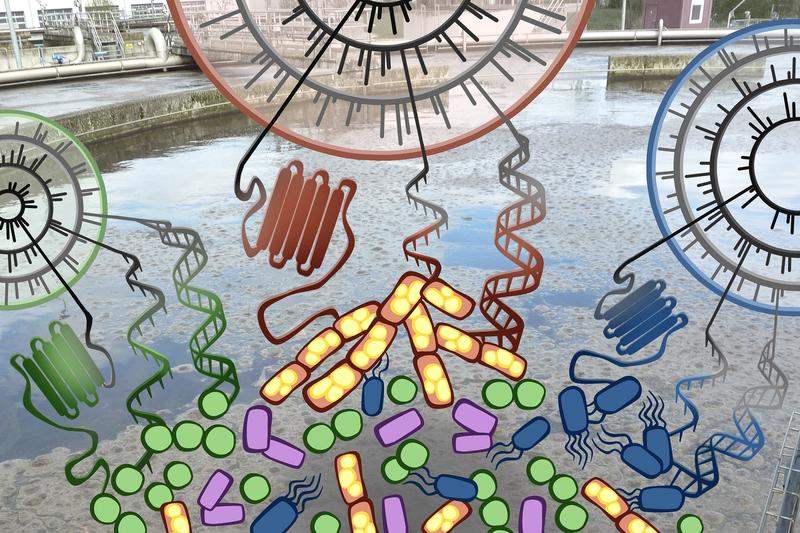

The LCSB researchers analyzed the genetic material of the different bacteria living in waste water treatment plant. (c) University of Luxembourg - LCSB
LCSB director Prof. Dr. Rudi Balling stresses the medical importance of these research efforts: “Bacterial ecosystems also play a major role in our health. We now have a better understanding of the laws governing their function.”
With their findings, the LCSB group of Prof. Dr. Paul Wilmes, head of the LCSB group “Ecosystems Biology” and ATTRACT-fellow of the Luxembourg National Research Fund (FNR), corroborate and unify various ecological concepts that have been primarily formulated based on observations in macrobiotic systems such as forests, rivers and oceans – which cannot however be experimentally investigated in depth because of the sheer size of these biotopes.
For their analyses of the treatment plant ecosystem, the researchers employed Systems Biology methods. Wastewater destined for treatment comprises energy-rich substrates including fats, proteins, carbohydrates and many other substances that serve as nutrients for the resident bacteria. Every wastewater treatment plant is therefore a complex ecosystem. Countless bacterial species adapt to the living conditions in the water, compete for resources and each find a niche in which they can best survive.
“The techniques developed at LCSB allow us now to unravel these processes very precisely at the molecular level,” says Dr. Emilie Muller, first author of the publication. The basis for this are the so-called “omics” – genomics, transcriptomics, proteomics and metabolomics – combined with new bioinformatic methods for integrated data analysis.
“With these, we can determine from samples which organisms are living in the treatment plant, and what their population sizes, genetic make-up, activities and material turnovers are like. Therefore, there is no longer any need to study bacteria separately in pure cultures,” Muller explains: “Based on this, we can ultimately model the material flows in the ‘treatment plant’ ecosystem and describe, for example, which bacterial species will use and consume which substrate and to what degree.”
Yet Emilie Muller wants to go further than simply modelling the wastewater treatment plant ecology: “We want to understand what factors determine the species composition and accordingly the balance in the ecosystem.” In this context, there is one species of bacteria that stands out and has grabbed the researchers’ attention: Microthrix parvicella, whose genome sequence the LCSB group first decrypted two years ago. This bacterium can absorb and store an especially large amount of lipids.
In winter, up to 50 percent of all bacteria on the surface of treatment tanks belong to this species. Emilie Muller continues: “That is rather astonishing, given that the amount of lipids in the wastewater is rather low in winter, and Microthrix actually has unfavourable living conditions during that season.” In their studies, Muller and colleagues then discovered that Microthrix possesses twenty-eight copies of the gene that is chiefly responsible for lipid uptake. “However, there are only ever a few of these homologous genes active at a given time and this fine-tuning is responsible for Microthrix’ ecological success,” Muller adds.
Paul Wilmes gives an interpretation of these facts: “Microthrix is what ecologists call a generalist. The organism can adapt to very many living conditions and thereby dominate the highly fluctuating wastewater treatment plant ecosystem.” This is helped, among other things, by the 28 genes for lipid uptake, Wilmes continues: “Each copy of the gene is a little different from the others. If the living conditions change, say when the temperature drops or the lipid composition changes, then a different lipid uptake gene adapted to that condition sets in. That way, Microthrix can survive in many different environments.” Wilmes’ aim is to boost the activity of Microthrix to remove as many lipids from the wastewater as possible. “The lipids from wastewater stored in the bacteria are a renewable energy source since they can be easily converted into biodiesel, for example.”
LCSB director Prof. Dr. Rudi Balling recognizes in ecosystems research an important basis for medical issues: “Paul Wilmes and his group have here corroborated fundamental concepts of ecology with comprehensive numerical data for the first time. This is important because our health is greatly determined by bacterial ecosystems like those in the gut or on the skin. When these fragile equilibriums are thrown out of balance, it can cause illnesses. We assume this is even the case for neurodegenerative diseases such as Parkinson’s disease. With the work from our Eco-Systems Biology group, we have come a long way towards understanding these systems – and actually being able to use that knowledge one day in medicine.”
The work was primarily supported by the ATTRACT and AFR fellowship schemes of the Luxembourg National Research Fund (FNR). The project also received financial support from the Integrated Biobank of Luxembourg (IBBL) with funds from the Luxembourg Ministry of Higher Education and Research.
The University of Luxembourg, founded in 2003, is a multilingual, international research university with 6200 students and staff from all over the globe. Its research focuses on computational sciences, law and especially European law, finance, educational sciences as well as interdisciplinary research conducted by the Interdisciplinary Centre for Security, Reliability and Trust (SnT) and the Luxembourg Centre for Systems Biomedicine (LCSB).
www.uni.lu
Notes to editors
Full bibliographic information: Emilie E. L. Muller, Nicolas Pinel, Cedric C. Laczny, Michael R. Hoopmann, Shaman Narayanasamy, Laura A. Lebrun, Hugo Roume, Jake Lin, Patrick May, Nathan D. Hicks, Anna Heintz-Buschart, Linda Wampach, Cindy M. Liu, Lance B. Price, John D. Gillece, Cedric Guignard, James M. Schupp, Nikos Vlassis, Nitin S. Baliga, Robert L. Moritz, Paul S. Keim & Paul Wilmes: Community-integrated omics links dominance of a microbial generalist to fine-tuned resource usage.
NATURE COMMUNICATIONS | 5:5603 | DOI: 10.1038/ncomms6603 |www.nature.com/naturecommunications. Nov 2014.
Weitere Informationen:
http://wwwen.uni.lu/lcsb – LCSB: Luxembourg Centre for Systems Biomedicine












